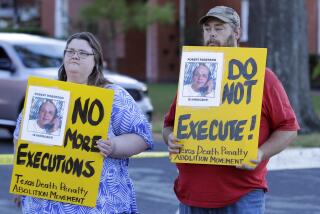DEATH PENALTY TWO VIEWS : Is There Justice in the Gas Chamber? : The deterrent effect is obvious. Why else would Harris and other death-row inmates so tirelessly challenge their sentences?
- Share via
The postponement of Robert Alton Harris’ execution has again put the issue of capital punishment in the national spotlight.
The death penalty for Harris is justified--not because human life should be treasured less but because civilized standards of behavior and the would-be victims of heinous murders should be loved more.
Harris’ conviction and death sentence for the murder of two teen-age boys 12 years ago have been reviewed and affirmed by 19 courts--the California Supreme Court on direct appeal and state and federal courts, including the U.S. Supreme Court, in collateral habeas corpus litigation. In the latest chapter of the odyssey, Judge John Noonan of the U.S. 9th Circuit Court of Appeals in San Francisco blocked Tuesday’s scheduled execution. On Monday, the U.S. Supreme Court refused California’s request to lift Noonan’s stay. Harris belatedly alleges incompetent psychiatric help at his 1978 trial.
The Harris case testifies to the wisdom of the death penalty: It deters murder more than the threat of life imprisonment. If it did not, neither Harris nor the estimated 2,200 others on Death Row in this country would be so tirelessly challenging their sentences.
Criminal justice studies regarding the death penalty are checkered, but those with the soundest methodology confirm a deterrent that is consistent with intuition and human nature. In the United States vs. Jackson (1968), the Supreme Court acknowledged a defendant’s greater fear of the death penalty than life imprisonment. It concluded that an accused would be unconstitutionally intimidated from exercising a right to jury trial if a waiver would foreclose a death sentence.
The deterrent is measurably weakened by the prolonged average eight-year wait (nationwide) between crime and punishment in death cases. Two reforms might slash that delay in half and bolster the deterrent without sacrificing reliability: Skilled death-penalty counsel should be appointed to represent indigents with death sentences during one full set of state and federal post-conviction challenges to the verdict; and collateral review of convictions and sentences should be barred (except for those based on newly discovered evidence) unless presented within six months of the termination of direct appeals.
Life sentences without parole are not a substitute for the death penalty. The deterrent is lessened because of the omnipresent potential for escape and renewed criminality, or executive clemency, including pardons. On his last day in office--obviously to escape public wrath--a recent governor of New Mexico commuted all death sentences.
Also, the death penalty is the only deterrent for murder committed by inmates under life sentences who exhibit characteristics akin to Harris’. These inmates are generally indifferent to moral restraints and would menace the life of every guard and fellow inmate. Indeed, in court papers, Harris’ counsel conceded his propensity for jail violence triggered “by anyone willing to show a modicum of kindness to him . . . (despite) the obvious negative consequences these behaviors would have for his case.”
Allegations that the death penalty threatens the innocent or is tainted by racism or is imposed cavalierly are contrary to facts. Careful and responsible studies document no contemporary case where the multiple safeguards in the administration of the death penalty failed to correct a potential miscarriage of justice.
Of prisoners on Death Row, 51% are Caucasian, 40% are black and 7% are Latino. Potential jurors may not be dismissed by prosecutors on the ground of race, and the U.S. Supreme Court in McCleskey vs. Kemp (1987) concluded that statistics failed to corroborate allegations that racism skewed administration of the death penalty. Further, the impressive 86% rate of citizen support for capital punishment nationwide does not fracture on racial lines.
Death sentences are scrupulously confined to a narrow category of vicious murders committed by insensate offenders. About two-thirds are previous felons, and 20% take lives when they are on parole or probation, in prison or after prison escape, or while criminal charges are pending.
The death penalty does not completely answer the unacceptable nationwide incidence of crime. But it is part of the answer, and deserves retention.
More to Read
Sign up for Essential California
The most important California stories and recommendations in your inbox every morning.
You may occasionally receive promotional content from the Los Angeles Times.










